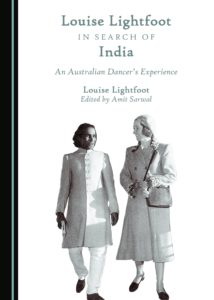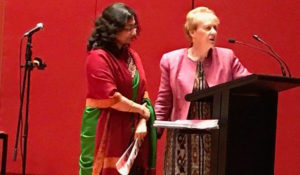In Search of India: Book launch and exhibition
On August 24, 2017, Prof. Cat Hope, Head of Sir Zelman Cowen School of Music at Monash University, opened the “In Search of India: Book Launch and Exhibition.”
A new book, titled Louise Lightfoot in Search of India: An Australian Dancers Experience, highlighting Australian connection to Indian classical dance was released by Ms Manika Jain, Consul General of India (Melbourne).
Prof. Cat Hope while inaugurating Music Archive of Monash University’s (MAMU) exhibition of Louise Lightfoot’s Manipuri and Kathakali dance costumes and jewellery, notes, letters, scrapbooks, and memorabilia noted “this is a great program, a great audience, a fantastic exhibition. Very proud to be part of it.”
Award-winning Professor of Ethnomusicology and Director of MAMU, Margaret Kartomi, AM, FAHA, says “The In Search of India event held at Monash University’s Music Auditorium was a celebration of the life and work of a remarkable Australian woman, Louise Lightfoot.”
“The celebration was presented by the Music Archive of Monash University (MAMU), which is the custodian of the Louise Lightfoot Bequest’s costumes, books, manuscripts, books, notes and scrapbooks,” she added.
According to Prof. Margaret Kartomi: “This remarkable woman’s pioneering achievement as a researcher of Indian (especially Manipuri) dance practice, and as an author, impresario and promoter of Indian-Australian relations should arguably be formally recognised posthumously by the Australian and Indian governments.”
The evening also included exquisite performances of songs by silken-voiced Mohit Pandit, lovely Indian dances by the 4th Dimension, and a fascinating panel discussion by social historian David Walker, Mary Louise Lightfoot (Lightfoot’s niece), choreographer Tara Rajkumar and author Amit Sarwal. The panel discussion covered the history of Australia-India relations during Louise’s life and her passionate promotion of Indian dance and culture to the Western world.
Well-known Indian-origin academic and translator Dr Amit Sarwal is presently an affiliate member of Contemporary Histories Research Group at Deakin University and the Founding Convenor of Australia-India Interdisciplinary Research Network. He is also a popular broadcaster with SBS Radio’s Hindi language service and has appeared as a featured expert on ABC Radio National, Sky News, Times of India, The Saturday Paper and other Indian community media.
Dr Sarwal says that as he delved deeper into MAMU’s archival collection, he realised that “despite decades of hard work and dedication to Indian dancing and creating awareness about India dance in Australia, Louise’s work and her collaboration with Indian artists is relatively unknown in both the countries.”
His book brings together thirty-three essays, reflecting Louise Lightfoot’s broader worldview as a dancer, choreographer, and impresario.
In 1930s, Louise, an architect turned impresario, founded the Lightfoot-Burlakov Classic Dance School and the First Australian Ballet with Misha Burlakov. Her growing interest in Indian classical dance took Louise to Kerala Kalamandalam in India. From here began her journey as an impresario for artists Ananda Shivaram, Rajkumar Priyagopal Singh, Lakshman Singh and Ibetombi Devi.
Louise’s writings on India and dance forms such as Ballet, Kathakali, and Manipuri appeared in a number of Australian, Indian and international newspapers and magazines. In 1958, she also published a full-length monograph, Dance-Rituals of Manipur, India: An Introduction to “Meitei Jagoi” and in 1960 released an album titled Ritual Music of Manipur.
Dr Amit Sarwal says that “today, Indian dance in Australia is represented by professional dance artists, companies, schools, and amateur community groups. But, it was Louise’s hard work in successfully promoting a range of Indian classical dance forms from 1947 onwards that has made this engagement possible.”
Prior to Louise Lightfoot’s intervention most theatrical ballet works alluding to India were replete with exoticism and stereotypes aimed at Western audiences.
“Louise Lightfoot as a dedicated impresario for Shivaram, Priyagopal Singh, and Ibetombi Devi, urged Australian audiences not to see Indian dance as just an ancient, mysterious, and spiritual art form, but try to truly understand the value of this complex art of Indian dance and culture in order to strengthen cultural bonds,” he adds.
In her foreword to Dr Sarwal’s book, Professor Emerita Margaret Allen of University of Adelaide, noted ”“ “In bringing together Lightfoot’s writing from a variety of Indian and Australian publications, Amit Sarwal is continuing some of Lightfoot’s own project and making a valuable contribution to fostering understanding between India and Australia.”
“In exploring the histories of Indian and Australian interactions, it is important to understand those who went before, who stood against the narrow-minded Anglo-conformism of cultural life in Australia and dared to travel, both physically and in the imagination to appreciate what was represented as the other and as incomprehensible,” she added.
In 1997, using some of the material from the MAMU, Tara Rajkumar created a dance plus “dialogic performance” called Temple Dreaming. This dance drama revived the memory of Louise Lightfoot and her passion for Kathakali.
Mary Louise Lightfoot, niece of Louise Lightfoot, says she was “intrigued by an old notebook of Louise’s and realising how little the family knew of her professional career, much of it outside Australia, decided to write an article about her aunt’s life.”
“On accessing the archival material held in the School of Music, I realised it might need a book,” she adds.
The result of her research was Lightfoot Dancing: An Indian-Australian Story. Mary notes that her book is “part biography, part dance history, part inter-generational memoir, and includes stories of the introduction of Indian Dance, Hatha Yoga, and Indian philosophies to the West.”
One of the audience members and an Adjunct Research Fellow at Monash Asia Institute, Dr Lisa Hames-Brooks, congratulated Dr Amit Sarwal and MAMU on “a wonderfully successful evening of dance and music celebrating Indian traditions and Louise Lightfoot’s contribution to the study of dance in India and Australia.”
This event was co-sponsored by Australia-India Interdisciplinary Research Network and Ethnic Link Labs in hope that this book will inspire scholars to engage deeply with the intellectual and cultural heritage of India and Au
Short URL: https://indiandownunder.com.au/?p=9540



